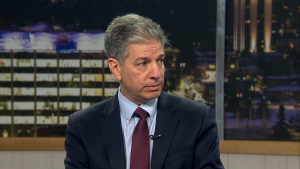
Ethan Berkowitz was interviewed by Lori Townsend during Alaska Insight, alongside challenger Rebecca Logan. Watch the full episode here.
Learn more about the other candidates
Alaska Public Media invited all of the 2018 Anchorage mayoral candidates to participate in an in-studio interview as well as a written questionnaire. Each candidate was offered the exact same questions. Incumbent candidate Ethan Berkowitz’s questionnaire submission is below.
What is the biggest challenge confronting Anchorage?
The biggest foundational challenge confronting Anchorage is public safety.
What is your specific policy solution to that problem?
The municipality has a limited number of levers at its disposal. However, we’ve worked to implement additional measures where we can, such as adding a joy riding ordinance to combat vehicle theft. We’re also working to increase collaboration between the MOA, the state and federal authorities in felony criminal prosecution, which is something that is currently only done by the State or the Feds. This week, for example we announced a new partnership with the State on prosecuting repeat DV felony assaults.
How will you vote on Ballot Measure One, and why?
I will vote no. It is wrong to single out any group of people for discriminatory treatment.
Do you think the proposed sale of Municipal Light and Power to Chugach Electric is a good thing for the city? Why or why not?
I do believe that the sale of ML&P to Chugach Electric is good for the city. This sale will save ratepayers money, stabilize the Municipality’s fiscal position, and insulate taxpayers from the state’s inability to solve its budgetary crisis. The money from the sale of ML&P will go into the MOA trust or be used to pay down Municipal debt.
How should Anchorage improve its local economy?
Economic development means cranes in the air. It means a dynamic city and a strong community. It means good jobs and good wages. We have done a lot over the last three years to make changes that will boost economic opportunities in Anchorage. We worked with the Legislature to pass legislation that allows Anchorage to make decisions about how and what kinds of development to incentivize. We have entered into and encouraged public-private partnerships for multiple developments around town, some of which mean shovels in the ground next year. We have refinanced old debt to save money and diversified our revenue stream to maintain our AAA bond rating. This helps investors recognize Anchorage as a stable environment to put down roots. While the state has not passed a significant capital budget in years, Anchorage has continued to pass bond packages, keeping jobs in the local economy. In 2018, we anticipate over $300 million of proposed new development in the city, including mixed use commercial and residential properties. Despite the state’s recession and the intrusion of online sales, Anchorage is attracting new business such as Duluth Trading Company, Dave and Buster’s, and Black Diamond. Local businesses, like King Street Brewery and Fire Island Bakery, are expanding. This positive energy helps build confidence in our economy and attracts businesses to our market. Companies across the globe locate where housing is affordable, energy is abundant and cheap, and where they can get access to new or expanded markets. My administration is focused on facilitating new residential development throughout the Municipality, in an effort to help bring down the high costs of housing in our community. We’re taking underutilized municipal land
and putting it out for private sector development, requiring that housing be a primary component of this redevelopment. Our efforts will lead to new housing in the U-Med District and throughout downtown, from Elizabeth Place at 7th Avenue and I Street to the Downtown Edge near the Alaska Railroad to the senior housing project planned for the current Department of Health and Human Services building. We have an opportunity to expand our role as a headquarter city for the businesses that have made Alaska prosperous — especially with resource development, logistics, and the success of Native Corporations. We can also be a leader in the renewable energy industry, as well as continue to expand tourism, encourage entrepreneurs, and explore ways to operate as the
gateway to an opening Arctic. We need to make sure our schools are strong and our community attractive for businesses both large and small. Anchorage is positioned to compete and succeed in the 21st Century global economy.
Are you satisfied with how the state-licensed cannabis businesses in Anchorage are regulated?
The state-licensed cannabis businesses in Anchorage have been operating well within the current laws.
What proposals do you have for addressing homelessness in Anchorage?
The causes of homelessness are complex, and represent both moral and fiscal challenges to Anchorage. Our goal is to make sure there is an ability to connect homeless individuals with services and support, an adequate stock of affordable housing, and a sustained, consistent effort to eliminate — not just manage — homelessness. Hundreds of homeless people have found housing in Anchorage over the past three years, including approximately 300 of the most expensive and hardest to serve individuals. We have
turned the tide, but sustained progress requires a maintenance of effort. Achievements have been made because the the city and nonprofits have had a strategic partnership, and have been able to align resources in unprecedented fashion. For example, together, we received a $1.3 million Pay-For-Success grant, which ultimately allows us to attract capital investment by harnessing the private sector profit motive with the public policy goal of solving homelessness. Anchorage was also awarded two HUD demonstration grants for housing solutions focused on young adults and chronically homeless adults. We are working with the community partners and social service organizations to help families and adults obtain housing and employment. Our homelessness strategy is based on metrics and evidence based solutions, such as “Housing First.” In 2016, we completed Anchorage’s first comprehensive “Homelessness Point in Time Survey,” identifying individuals by name and helping connect them with essential services. This was a first step in an approach targeting the root causes of homelessness, and helping some of our most vulnerable residents regain self-sufficiency and independence. It also accelerated our ability to provide the coordinated referral system that represents best practices and allows providers to be most impactful with rental assistance and case management. We have implemented efforts to address pressure at shelters by connecting individuals with services in place. For example, we recently linked resources to APD and AFD, which have substantially decreased incident reports at the Bean’s and Brother Francis campus. In 2017, we embedded a social services coordinator in the Community Action Policing Team, and in 2018, we expanded this to include a mental health position. This has been very effective in significantly reducing calls for police and fire service, which are now directed to other community resources. In addition, we have been working with Cook Inlet Tribal Council, RurAl CAP and the Anchorage Coalition to End Homelessness on implementing a $2 million Substance Abuse and Mental Health Services Administration grant that will expand service opportunities for those experiencing homelessness, substance abuse and mental health disorders.
How would you like to see the Anchorage Police Department deploy its limited resources to most effectively handle crime?
The police department is the most significant lever the Municipality of Anchorage has to contain and combat crime, which is why we have added approximately 100 officers to the force. When I was first elected, the police department was at a dangerously low staffing level. In 2015, APD had 320 sworn officers–we now have 436. At current levels, the Department has bolstered specialty units targeting drugs, robbery, sexual assault, and violent crime. We have also been able to launch new initiatives. For example, APD created the Investigative Support Unit (ISU) in the Crime Suppression Division; in the first two months of operation, the ISU made more than 60 arrests. This unit–which targets the worst offenders–was made possible because of the increase in police officers at APD. In addition, the increase in police officers has allowed APD to take on more crime prevention measures. Two retail theft stings at WalMart and Fred Meyer have led to more than 20 arrests. Additionally, property crime detectives worked with the US Attorney’s office to federally charge 13 people with vehicle theft related crimes to combat the increase in stolen vehicles. As more police officers complete their training, we’ll be able to implement even more preventative actions in the municipality.
Addressing Anchorage’s public safety is about catching criminals, but it is also about preventing crime and punishing criminals once they have been arrested. Anchorage now has dedicated foot and bike patrols in Mountain View, Fairview, Spenard and Downtown, bringing more officers into the community and on the streets. This summer, because we have a bigger department, we plan to align APD’s beats with community council boundaries, allowing police officers to build stronger relationships with the communities they serve, which has a preventative benefit.
What do you think is the best thing about living in Anchorage?
Anchorage is an amazing place with amazing people. The scenery, the wildlife, the culture, the food — and the unexpected moments that come from conversations and experiences with all kinds of people.
Learn more about the other candidates
Originally from the Central Coast of California, Valerie joined Alaska Public Media in July 2017. She creates original video content for the station's TV and digital platforms while also overseeing the Production Department. Before moving to Alaska, Valerie worked as an ENG Editor at WRAL-TV in Raleigh, North Carolina. She also served in the U.S. Air Force as a TV and Radio Broadcast Journalist where she traveled around Europe, Africa, The Baltics, Australia, and the Southern United States reporting on military events, exercises, and missions. Outside of work, she enjoys hiking, backcountry skiing, backpacking, yoga, and traveling.





